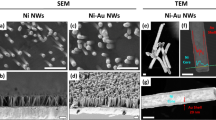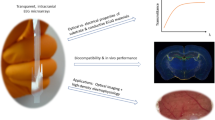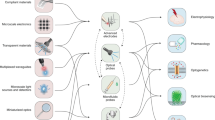Abstract
Carbon nanotubes have been applied in several areas of nerve tissue engineering to probe and augment cell behaviour, to label and track subcellular components, and to study the growth and organization of neural networks. Recent reports show that nanotubes can sustain and promote neuronal electrical activity in networks of cultured cells, but the ways in which they affect cellular function are still poorly understood. Here, we show, using single-cell electrophysiology techniques, electron microscopy analysis and theoretical modelling, that nanotubes improve the responsiveness of neurons by forming tight contacts with the cell membranes that might favour electrical shortcuts between the proximal and distal compartments of the neuron. We propose the ‘electrotonic hypothesis’ to explain the physical interactions between the cell and nanotube, and the mechanisms of how carbon nanotubes might affect the collective electrical activity of cultured neuronal networks. These considerations offer a perspective that would allow us to predict or engineer interactions between neurons and carbon nanotubes.
This is a preview of subscription content, access via your institution
Access options
Subscribe to this journal
Receive 12 print issues and online access
$259.00 per year
only $21.58 per issue
Buy this article
- Purchase on Springer Link
- Instant access to full article PDF
Prices may be subject to local taxes which are calculated during checkout






Similar content being viewed by others
References
Silva, G. A. Neuroscience nanotechnology: progress, opportunities and challenges. Nature Rev. Neurosci. 7, 65–74 (2006).
Silva, G. A. Nanotechnology approaches for drug and small molecule delivery across the blood brain barrier. Surg. Neurol. 67, 113–116 (2007).
Fortina, P., Kricka, L. J., Surrey, S. & Grodzinski, P. Nanobiotechnology: the promise and reality of new approaches to molecular recognition. Trends Biotechnol. 23, 168–173 (2005).
Parpura, V. Instrumentation: carbon nanotubes on the brain. Nature Nanotech. 3, 384–385 (2008).
Krishnan, A., Dujardin, E., Ebbesen, T. W., Yianilos, P. N. & Treacy, M. M. J. Young's modulus of single-walled nanotubes. Phys. Rev. B 58, 14013–14019 (1998).
Harrison, B. S. & Atala, A. Carbon nanotube applications for tissue engineering. Biomaterials 28, 344–353 (2007).
Giugliano, M., Prato, M. & Ballerini, L. Nanomaterial/neuronal hybrid system for functional recovery of the CNS. Drug Discov. Today: Disease Models, doi: 10.1016/j.ddmod.2008.07.004 (2008).
Keefer, E. W., Botterman, B. R., Romero, M. I., Rossi, A. F. & Gross, G. W. Carbon nanotube coating improves neuronal recordings. Nature Nanotech. 3, 434–439 (2008).
Ballerini, L. Bridging multiple levels of exploration: towards a neuroengineering-based approach to physiological and pathological problems in neuroscience. Frontiers Neurosci. 2, 24–25 (2008).
Mazzatenta, A. et al. Interfacing neurons with carbon nanotubes: electrical signal transfer and synaptic stimulation in cultured brain circuits. J. Neurosci. 27, 6931–6936 (2007).
Mattson, M. P., Haddon, R. C. & Rao A. M. Molecular functionalization of carbon nanotubes use as substrates for neuronal growth. J. Mol. Neurosci. 14, 175–182 (2000).
Hu, H., Ni, Y., Montana, V., Haddon, R. C. & Parpura, V. Chemically functionalized carbon nanotubes as substrates for neuronal growth. Nano Lett. 4, 507–511 (2004).
Hu, H. et al. Polyethyleneimine functionalized single-walled carbon nanotubes as a substrate for neuronal growth. J. Phys. Chem. B 109, 4285–4289 (2005).
Lovat, V. et al. Carbon nanotube substrates boost neuronal electrical signaling. Nano Lett. 5, 1107–1110 (2005).
Galvan-Garcia, P. et al. Robust cell migration and neuronal growth on pristine carbon nanotube sheets and yarns. J. Biomater. Sci. Polym. Ed. 18, 1245–1261 (2007).
Schaefer, A. T., Larkum, M. E., Sakmann, B. & Roth, A. Coincidence detection in pyramidal neurons is tuned by their dendritic branching pattern. J. Neurophysiol. 89, 3143–3154 (2003).
Kirckpatrick, S. Percolation and conduction. Rev. Mod. Phys. 45, 574–588 (1972).
Larkum, M. E., Kaiser, K. M. & Sakmann, B. Calcium electrogenesis in distal apical dendrites of layer 5 pyramidal cells at a critical frequency of back-propagating action potentials. Proc. Natl Acad. Sci. USA 96, 14600–14604 (1999).
Larkum, M. E., Waters, J., Sakmann, B. & Helmchen, F. Dendritic spikes in apical dendrites of neocortical layer 2/3 pyramidal neurons. J. Neurosci. 27, 8999–9008 (2007).
Seamans, J. K., Gorelova, N. A. & Yang, C. R. Contributions of voltage-gated Ca2+ channels in the proximal versus distal dendrites to synaptic integration in prefrontal cortical neurons. J. Neurosci. 17, 5936–5948 (1997).
Young, C. E. & Yang, C. R. Dopamine D1/D5 receptor modulates state-dependent switching of soma-dendritic Ca2+ potentials via differential protein kinase A and C activation in rat prefrontal cortical neurons. J. Neurosci. 24, 8–23 (2004).
Markram, H., Helm, P. J. & Sakmann, B. Dendritic calcium transients evoked by single back-propagating action potentials in rat neocortical pyramidal neurons. J. Physiol. 485, 1–20 (1995).
Nyberg, T., Shimada, A. & Torimitsu, K. Ion conducting polymer microelectrodes for interfacing with neural networks. J. Neurosci. Methods 160, 16–25 (2007).
Gelain, F., Bottai, D., Vescovi, A. & Zhang, S. Designer self-assembling peptide nanofiber scaffolds for adult mouse neural stem cell 3-dimensional cultures. PLoS ONE 1, e119 (2006).
Larkum, M. E., Senn, W. & Lüscher, H. R. Top-down dendritic input increases the gain of layer 5 pyramidal neurons. Cereb. Cortex 14, 1059–1070 (2004).
Horowitz, P. & Hill, W. The Art of Electronics 2nd edn (Cambridge Univ. Press, 1989).
Robinson, D. A. The electrical properties of metal microelectrodes. Proc. IEEE 56, 1065–1071 (1968).
Georgakilas, V. et al. Organic functionalization of carbon nanotubes. J. Am. Chem. Soc. 124, 760–761 (2002).
Peters, A., Palay, S. L. & Webster, H. F. The Fine Structure of the Nervous System (Oxford Univ. Press, 1991).
Pastorin, G. et al. Double functionalization of carbon nanotubes for multimodal drug delivery. Chem. Commun. 11, 1182–1184 (2006).
Markram, H., Lübke, J., Frotscher, M. & Sakmann, B. Regulation of synaptic efficacy by coincidence of postsynaptic APs and EPSPs. Science 275, 213–215 (1997).
Giugliano, M., Darbon, P., Arsiero, M., Lüscher, H. R. & Streit, J. Single-neuron discharge properties and network activity in dissociated cultures of neocortex. J. Neurophysiol. 92, 977–996 (2004).
Christie, B. R., Eliot, L. S., Ito, K., Miyakawa, H. & Johnston, D. Different Ca2+ channels in soma and dendrites of hippocampal pyramidal neurons mediate spike-induced Ca2+ influx. J. Neurophysiol. 73, 2553–2557 (1995).
Magee, J. C. & Carruth, M. Dendritic voltage-gated ion channels regulate the action potential firing mode of hippocampal CA1 pyramidal neurons. J. Neurophysiol. 82, 1895–1901 (1999).
Kampa, B. M. & Stuart, G. J. Calcium spikes in basal dendrites of layer 5 pyramidal neurons during action potential bursts. J. Neurosci. 26, 7424–7432 (2006).
Acknowledgements
We are grateful to A. Roth, A. Schaefer and I. Riachi for helpful discussions, K.-H. Boven for providing ITO substrates, C. Zacchigna for assistance with tissue cultures, C. Gamboz and A. Mazzatenta for TEM procedures, and to L. Sivilotti for comments on the previous version of this manuscript. Financial support from EPFL (to M.G., L.G. and H.M.), EU (NEURONANO-NMP4-CT-2006-031847 to M.P., M.G., H.M. and L.B.), CARIPLO (to F.G.), Fondazione Alberto and Kathleen Casali, and Progetto D4 Area Science Park mobility program (to E.C.) is gratefully acknowledged.
Author information
Authors and Affiliations
Corresponding author
Supplementary information
Supplementary Information
Supplementary Information (PDF 877 kb)
Rights and permissions
About this article
Cite this article
Cellot, G., Cilia, E., Cipollone, S. et al. Carbon nanotubes might improve neuronal performance by favouring electrical shortcuts. Nature Nanotech 4, 126–133 (2009). https://doi.org/10.1038/nnano.2008.374
Received:
Accepted:
Published:
Issue Date:
DOI: https://doi.org/10.1038/nnano.2008.374
This article is cited by
-
Neuro-nanotechnology: diagnostic and therapeutic nano-based strategies in applied neuroscience
BioMedical Engineering OnLine (2023)
-
Comparison of fractal and grid electrodes for studying the effects of spatial confinement on dissociated retinal neuronal and glial behavior
Scientific Reports (2022)
-
Three-dimensional conductive polycaprolactone/carbon nanotubes scaffolds for peripheral nerve regeneration
Journal of Materials Science (2022)
-
Graphene foam/hydrogel scaffolds for regeneration of peripheral nerve using ADSCs in a diabetic mouse model
Nano Research (2022)
-
Novel carbon film induces precocious calcium oscillation to promote neuronal cell maturation
Scientific Reports (2020)



